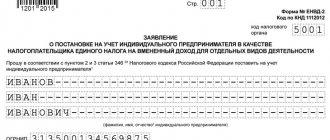According to the current legislation of the Russian Federation, the basic monthly profitability is a monetary amount that corresponds to the conditional profitability of a certain type of business activity per 1 unit of physical indicator. This service can greatly facilitate the maintenance of UTII and other nuances of accounting in order to minimize risks and save time.
In our publication today, we will find out what the basic yield of UTII is, and we will tell you how to calculate the basic yield. At the bottom of this page there is a table of basic UTII profitability for 2020 by type of activity.
Basic profitability and physical indicator of UTII
The basic monthly profitability of an individual entrepreneur is considered conditional, since its size does not depend on the actual earnings of an individual entrepreneur.
The UTII profitability is assigned by the government for each type of business activity that falls under this tax regime per 1 employee/1 sq. meter of retail space/1 seat and other physical indicators that characterize each individual type of individual entrepreneur activity. The physical indicator of UTII is a combination of the above units that participate in production (in the provision of services).
Thus, both the size of the basic profitability and the value of the physical indicator for each type of entrepreneurial activity of an individual entrepreneur on UTII will be different.
The physical indicator for basic profitability can be numerically equal to the number of employees, the area of the premises in “squares”, and the number of seats.
The amount of basic income for a single tax on imputed income for 2020 is established by Article 346.29 of the Tax Code of the Russian Federation, which lists all types of activities with basic UTII income.
For convenience, all types of business activities, physical indicators and basic profitability (in rubles) are presented in the table at the end of the article.
Table of basic yield of UTII 2020
The table below for 2020 shows profitability for all types of business activities for which UTII, physical indicators and basic monthly profitability can be applied:
| Types of business activities | Physical indicator of UTII (2020) by type of activity | Basic income 2020 per month (rubles) |
| 1 | 2 | 3 |
| Provision of household services | Number of employees, including individual entrepreneurs | 7 500 |
| Provision of veterinary services | Number of employees, including individual entrepreneurs | 7 500 |
| Providing repair, maintenance and washing services for motor vehicles | Number of employees, including individual entrepreneurs | 12 000 |
| Provision of services for the provision of temporary possession (for use) of parking spaces for motor vehicles, as well as for the storage of motor vehicles in paid parking lots | Total parking area (in square meters) | 50 |
| Provision of motor transport services for the transportation of goods | Number of vehicles used to transport goods | 6 000 |
| Provision of motor transport services for the transportation of passengers | Number of seats | 1 500 |
| Retail trade carried out through stationary retail chain facilities with trading floors | Sales area (in square meters) | 1 800 |
| Retail trade carried out through facilities of a stationary retail chain that do not have sales floors, as well as through facilities of a non-stationary retail chain, the area of the retail space in which does not exceed 5 square meters | Number of retail places | 9 000 |
| Retail trade carried out through stationary retail chain facilities that do not have trading floors, as well as through non-stationary retail chain facilities with a retail space exceeding 5 square meters | Area of retail space (in square meters) | 1 800 |
| Delivery and distribution retail trade | Number of employees, including individual entrepreneurs | 4 500 |
| Sales of goods using vending machines | Number of vending machines | 4 500 |
| Provision of public catering services through a public catering facility with a customer service hall | Area of the visitor service hall (in square meters) | 1 000 |
| Provision of public catering services through a public catering facility that does not have a customer service hall | Number of employees, including individual entrepreneurs | 4 500 |
| Distribution of outdoor advertising using advertising structures (except for advertising structures with automatic image changes and electronic displays) | Area intended for printing (in square meters) | 3 000 |
| Distribution of outdoor advertising using advertising structures with automatic image changes | Exposure surface area (in square meters) | 4 000 |
| Distribution of outdoor advertising using electronic signs | Light emitting surface area (in square meters) | 5 000 |
| Advertising using external and internal surfaces of vehicles | Number of vehicles used for advertising | 10 000 |
| Provision of temporary accommodation and accommodation services | Total area of premises for temporary accommodation and living (in square meters) | 1 000 |
| Provision of services for the transfer for temporary possession and (or) use of retail spaces located in facilities of a stationary retail chain that do not have trading floors, facilities of a non-stationary retail chain, as well as public catering facilities that do not have customer service halls, if the area of each they do not exceed 5 square meters | Number of trading places, non-stationary retail chain facilities, and public catering facilities transferred for temporary possession and (or) use | 6 000 |
| Provision of services for the transfer for temporary possession and (or) use of retail spaces located in facilities of a stationary retail chain that do not have trading floors, facilities of a non-stationary retail chain, as well as public catering facilities that do not have customer service halls, if the area of each exceeds 5 square meters | Area of a retail space, a non-stationary retail chain facility, or a public catering facility transferred for temporary possession and (or) use (in square meters) | 1 200 |
| Provision of services for the transfer of temporary possession and (or) use of land plots for the placement of stationary and non-stationary retail chain facilities, as well as public catering facilities, if the area of the land plot does not exceed 10 square meters | Number of land plots transferred for temporary possession and (or) use | 10 000 |
| Provision of services for the transfer of temporary possession and (or) use of land plots for the placement of stationary and non-stationary retail chain facilities, as well as public catering facilities, if the area of the land plot exceeds 10 square meters | Area of land transferred for temporary possession and (or) use (in square meters) | 1 000 |
It is worth saying that some types of activities are shown in the table in general. Therefore, for example, the question may arise, “What is the basic profitability for UTII for hairdressing services in 2020?” The provision of services by hairdressing salons and beauty salons is classified as household services with code 96.02 according to OKVED 2, which can also be transferred to UTII (clause 1, clause 2, article 346.26 of the Tax Code of the Russian Federation, Government Order No. 2496-r dated November 24, 2016). And for household services, the basic income on UTII is set at 7,500 rubles per month for each employee, including individual entrepreneurs.
It should also be borne in mind that for similar types of activities the basic profitability may be different. So, when applying UTII for retail trade, the basic profitability per month can be:
- 1,800 rubles - for retail trade, which is carried out through objects of a stationary trading network that have trading floors, through objects of a stationary trading network that do not have trading floors, as well as through objects of a non-stationary trading network, the sales area of which exceeds 5 sq.m. ;
- 9,000 rubles – for retail trade, which is carried out through objects of a stationary retail chain that do not have sales floors, as well as through objects of a non-stationary retail chain, the area of a retail space in which does not exceed 5 sq.m.;
- 4,500 rubles – for distribution and retail trade.
How to calculate UTII in 2020?
In order to calculate the UTII tax, you must use a special formula. One of the components of this formula is the basic yield.
Let's take a closer look at the formula for calculating the UTII tax.
UTII = (BD X FP X K1 X K2×15%), where: UTII is the amount of tax in rubles (for one month); BD - basic profitability established by tax legislation (for a certain type of activity); FP is a physical indicator of the activity of an individual entrepreneur (number of employees, area of retail premises, etc., depending on the type of services provided by the individual entrepreneur); K1 is the deflator coefficient, which is set for the year by the Government of the Russian Federation; K2 - adjustment coefficient, which is approved for each type of service (by local governments of the region), for a period of 1 year or more; 15% is the current UTII rate.
In 2020, K1 for UTII increased to 1.915. Consequently, the tax burden on entrepreneurs using UTII increased in 2020 in terms of calculation and payment of UTII, which depends on K1.
K2 for individual entrepreneurs on UTII in 2020 can range from 0.005 to 1 points (the K2 coefficient can be clarified at the tax office).
K1 for 2020 will be determined approximately in November 2020. As soon as the Russian Ministry of Economic Development publishes the corresponding order, we will definitely inform our readers about K1 set for 2020.
Due to the fact that individual entrepreneurs’ reporting on UTII is submitted quarterly, the amount of tax calculated using the formula is multiplied by 3 months.
What is taken into account when calculating imputed income
The UTII regime in 2020 for individual entrepreneurs and LLCs is attractive because the income expected or imputed by the state is often lower than what the taxpayer actually receives. Accordingly, the lower the expected income, the lower the tax payable.
Basic yield (BR) is the amount of income in rubles that is assumed to be received by the taxpayer. For example, one employee in the field of personal services brings in an income of 7,500 rubles per month, one square meter of sales area - 1,800 rubles, and one vehicle for cargo transportation - 6,000 rubles.
The basic income figures in the Tax Code of the Russian Federation are indicated for one unit of physical indicator (FI) - an employee, a square meter, a unit of transport, etc. It is easy to calculate that three employees employed in household services on UTII in 2020 for individual entrepreneurs bring an imputed income (3 * 7,500) 22,500 rubles per month. Of course, in practice, three employees in household services bring in much larger sums, but it is this imputed income that is taken into account when calculating the tax.
Thus, the calculation of UTII for a taxpayer is based on two main elements of the formula:
- basic yield (BR);
- physical indicator (PI).
In addition, the formula contains two more coefficients that adjust the calculated imputed income:
- K1 is a deflator coefficient that takes into account the increase in consumer prices (for LLCs and individual entrepreneurs in 2020 it is 2.005).
- K2 is a regional coefficient that is set by the local administration and can reduce the amount of calculated imputed income (ranges from 0.005 to 1).
The full formula for calculating EVND 2020 (tax amount per month) will be as follows:
BD * FP * K1 * K2 * 15%
Prepare a UTII declaration for only 149 rubles
Current changes in UTII
The basic yield of the UTII tax for 2020 remains unchanged, but this does not mean that the amounts paid by individual entrepreneurs for UTII in 2020 will be the same in 2020. This is due to the fact that the formula for calculating UTII contains variable coefficients K1 and K2, as well as the fact that regional authorities are allowed to set the UTII tax rate themselves from 15% to 7.5%. Accordingly, in different regions of the Russian Federation the UTII rate will be different. Its size will depend on what kind of rate the local authorities will accept.
These authorities are:
- representative bodies of municipal districts;
- representative bodies of urban districts;
- legislative (representative) government bodies of federal cities of Moscow, St. Petersburg and Sevastopol.
Unlike K1, which is set at the federal level, K2 is allowed to be set by local authorities, but, as a rule, in most regions it is equal to 1, i.e. does not affect the amount of UTII.
The definition of K2 is presented in Art. 346.27 of the Tax Code of the Russian Federation (hereinafter referred to as the Tax Code of the Russian Federation) is an adjusting coefficient of basic profitability, which includes taking into account various features of doing business. K2 depends on the list of works provided, services or goods sold, seasonality and operating hours, the amount of income received, etc.
In some regions, K2 must be calculated using a formula approved by local authorities.
Reducing UTII by fixed contributions
Let us remind you that from 01/01/2017, an individual entrepreneur who has employees has the right to reduce UTII by the amount of fixed contributions paid to the funds within 50% of the calculated UTII.
Until 2020, individual entrepreneurs on UTII using hired labor reduced UTII only by contributions paid for employees within 50% of the calculated UTII; UTII was not reduced by contributions paid for the individual entrepreneur himself. In 2020, the rule for reducing UTII for insurance premiums will continue to apply.
VAT FOR UTII IN 2020
Law No. 335-FZ of November 27, 2020 determines that entrepreneurs using UTII can deduct value added tax on the following grounds:
- Art. 161 of the Tax Code of the Russian Federation (tax agents);
- Art. 174.1 of the Tax Code of the Russian Federation (simple partnership, joint venture, investment partnership, trust, concession).
Changes to UTII in 2020: draft law
Regarding this taxation system, it is worth noting that UTII was previously going to be abolished from the beginning of 2020. However, a draft law has been submitted to the State Duma for consideration, by which the validity of UTII should be extended until 2021, but, unfortunately, not for all types of activities. The draft law provides for leaving UTII only for individual entrepreneurs providing services to the population. How it will actually be, time will tell.
Another bill proposes amendments to the Tax Code of the Russian Federation (Article 346.27). The bill introduces a new formulation of the concept of “retail trade for UTII purposes.” If this amendment is adopted, then within the framework of UTII it will be impossible to sell goods that are subject to labeling in accordance with the legislation of the Russian Federation and (or) the law of the Eurasian Economic Union by means of identification. The Government of the Russian Federation, by its order No. 792-r dated April 28, 2018, approved the List of goods that must be labeled in 2020. This list includes a number of consumer goods - clothing, shoes, perfumes, etc.
To date, a positive decision on the use of UTII has been made for consumer cooperatives. From December 31, 2107, it was planned to prohibit this category of business from using UTII. But on the basis of clause 4 of Art. 3 of the Law of October 2, 2012 No. 161-FZ, as amended by the Law of October 30, 2020 No. 300-FZ, this deadline has been postponed until 2021.
We will inform our readers about any changes in legislation in a timely manner.
The material has been updated in accordance with changes in the legislation of the Russian Federation on September 14, 2019
Correction factors K1 and K2
In addition to the basic profitability and physical indicator, two adjustment factors are used in the UTII calculation formula.
K1 is a deflator coefficient, which is set by the government of the Russian Federation for one year.
Let us remind you that in 2020 and 2020 K1 did not increase and remained at the 2020 level - 1.798.
In 2020, K1 for calculating UTII was increased for the first time after maintaining the three-year indicator and amounted to 1.868.
In 2020, K1 was 1.915.
In 2020, K1 is 2.009.
K2 is a coefficient that is set by local authorities for one year for all types of services.
The K2 value can be found on the Federal Tax Service website or at your tax office.
This might also be useful:
- Calculation of UTII for less than a month in 2020
- Changes in UTII for individual entrepreneurs in 2020
- UTII for individual entrepreneurs in 2020
- Codes of types of entrepreneurial activity UTII
- Retail trade on UTII in 2020
- What taxes does the individual entrepreneur pay?
Is the information useful? Tell your friends and colleagues
Dear readers! The materials on the TBis.ru website are devoted to typical ways to resolve tax and legal issues, but each case is unique.
If you want to find out how to solve your specific issue, please contact the online consultant form. It's fast and free!
List of activities under UTII for 2018
We can name 14 types of activities falling under UTII in 2018. This:
1. Household services.
To identify household services as types of activity on UTII in 2020, use their codes from the All-Russian Classifier:
- types of economic activity (OKVED);
- products (OKP).
2. Treatment and prevention for animals.
3. Repair, maintenance and washing of vehicles.
4. Renting out parking spaces, including for the purpose of storing cars (except for impound lots).
5. Transportation of people and cargo by no more than 20 vehicles.
6. Retail trade through shops and pavilions with a sales area of up to 150 sq. m. m for each object.
7. Retail trade through:
- stationary facilities without trading floors;
- mobile objects.
8. Catering with a service hall up to 150 sq. m for each object.
9. Catering without a service hall.
10. Street advertising through special structures.
11.Advertising on vehicles.
12. Temporary accommodation and residence services with a total area of the relevant premises up to 500 square meters. m;
13. Renting:
- retail spaces in a stationary retail chain without sales floors;
- objects of non-stationary trade;
- catering facilities without a service hall.
14. Leasing of land plots for the placement of a stationary and non-stationary retail chain, as well as public catering.
These are the types of entrepreneurial activities for UTII in 2018. Compared to 2017, this list has not changed. There were no global changes in tax law.
We have listed all possible types of activities on UTII in 2018. However, it is not enough to know what types of activities UTII falls under. It is also important that a local law be adopted that gives the go-ahead for the introduction of “imputation” for one or more of the listed occupations.
Comments
Gamlet 02/15/2016 at 01:33 pm # Reply
... Everything that is convenient for people should definitely be cancelled. Miracle Country...
Tatyana 03/22/2016 at 09:33 # Reply
SP
Is a 10 m2 tent considered a sales area?
Natalia 03/22/2016 at 01:54 pm # Reply
Tatyana, good afternoon. The concept of a trading floor is defined by the Tax Code of the Russian Federation, Article 346.27, I quote: “the area of a trading floor is a part of a store, pavilion (open area) occupied by equipment intended for displaying, demonstrating goods, conducting cash payments and servicing customers, the area of cash registers and cash registers cabins, the area of working places for service personnel, as well as the area of aisles for customers. The area of the trading floor also includes the rented part of the trading floor area. The area of utility, administrative and amenity premises, as well as premises for receiving, storing goods and preparing them for sale, in which customer service is not provided, does not apply to the area of the trading floor. The area of the sales area is determined on the basis of inventory and title documents;" My opinion is because The area of the sales floor can be determined on the basis of inventory and title documents, but in relation to the tent, such documents simply do not exist, because a tent is a temporary structure, then the answer to your question is no.
Dilik 10/27/2016 at 08:32 pm # Reply
More than 5 m2, it counts as a service room, but since it’s a tent, I don’t know)
Rosalia 04/23/2016 at 10:11 am # Reply
How to properly allocate an area
How to correctly allocate an area for calculating the UTII if a room of 50 sq.m also contains the entire assortment and passage of buyers and the seller’s area?
Nail 07/05/2016 at 18:48 # Reply
I bought a Hyundai bus with 19 seats and will service it on my own. The company delivers shifts as an individual entrepreneur. I wanted to find out what is the price of K2 in Kazan
Natalia 07/06/2016 at 08:16 # Reply
Nail, good afternoon. When providing motor transport services for the transportation of passengers, for individual entrepreneurs working in Kazan, K2 is set to 0.5 for the purpose of calculating UTII.
Marina 11/10/2016 at 11:43 am # Reply
Salt mines - do household services fall under UTII?
Hello. Salt mines - do household services fall under UTII? Region 34-Volgograd. Thank you.)
Natalia 11/13/2016 at 01:19 pm # Reply
Marina, good afternoon. UTII when providing services - salt caves cannot be used. The list of permitted types of activities under UTII is specified in clause 2 of Article 346.26 of the Tax Code of the Russian Federation; regional authorities cannot expand it.
Anastasia 01/16/2017 at 11:50 # Reply
In accordance with Federal Law No. 178-FZ dated June 2, 2016, the UTII tax regime has been extended until January 1, 2021. How come you wrote the last update on November 29, 2016?
ostapx1 01/16/2017 at 11:52 am # Reply
What exactly bothers you?
11/21/2017 at 04:37 pm # Reply
Question
Hello. Tell me, please, does the construction of cottages fall under UTII - the provision of services to the population?
11/21/2017 at 5:45 pm # Reply
Construction of cottages - OKVED code 41.20.30 falls under UTII.
12/05/2017 at 20:51 # Reply
Hello! Is OKVED 93.29.9 suitable for UTII taxation? In my case, these are educational and entertainment devices for children.
12/05/2017 at 21:45 # Reply
Good afternoon. OKVED code 93.29.9 by Order of the Government of the Russian Federation of November 24, 2016 N 2496-R is classified as household services, therefore, it can be used for UTII.






